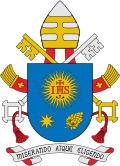20th century
In 1942, Pope Pius XII consecrated the whole of humanity, which implicitly included Russia but not by name, to the Immaculate Heart of Mary. This consecration was made in the context of the reported messages from Jesus and the Virgin Mary received by Alexandrina of Balazar and communicated to her spiritual director, the Jesuit priest Mariano Pinho. In 1952, he consecrated "the peoples of Russia" to the Immaculate Heart in Sacro vergente anno , although it was notably not done in communion with bishops worldwide (as requested by Our Lady of Fátima). [9] [10] [11] [12]
In 1964, Pope Paul VI also consecrated humanity, and thus implicitly Russia, to the Immaculate Heart of Mary at the end of the third session of Vatican II. [10] [13] [14] [15]
In 1981 and 1982, Pope John Paul II also consecrated the whole human race to the Immaculate Heart of Mary. [9] [10]
All those previous consecrations were done not in communion and coordination with the Catholic bishops of the world. [9]
In 1983, Pope John Paul II set out to rectify any errors that had occurred with the previous consecrations; and on December 8, 1983, he sent a letter to all bishops worldwide, Catholic and Orthodox, asking them to join him in March 1984 for an Act of Entrustment to the Immaculate Heart of Mary. [16] Before doing the consecration, the pope consulted Sister Lúcia so as to make sure this consecration of Russia would be valid. However, on March 25, 1984, Pope John Paul II did not mention Russia when he declared an act of consecration of "those men and nations who are in special need of this entrustment and consecration." [17] After John Paul II's consecration, Sister Lúcia stated numerous times that the 1984 consecration had been done the way the Virgin Mary wanted it to be. [9] [10]
21st century
At the formal request of the Episcopal Conference of Ukrainian Catholic Bishops, the Holy See announced on 15 March 2022 that Pope Francis would consecrate Russia and Ukraine to the Immaculate Heart of Mary on 25 March 2022 at Saint Peter's Basilica in Rome. The 25 March date is the same date as when John Paul II consecrated Russia to the Immaculate Heart in 1984. A consecration ceremony was also scheduled in Fátima, Portugal by the papal almoner, Cardinal Konrad Krajewski. [18] [19] Accordingly, the Pope sent a letter to invite all the Catholic bishops to join with him in the consecration, by their own volition, at the same designated time the consecration by the pope was to take place. [20] [10] He also invited all Catholic communities and all the faithful to join him in the consecration. [21] The text of the consecration contains explicit mentions of "Russia and Ukraine" in the consecration formula. [22]
The Saint Peter's Basilica consecration took place in conjunction with a penitential service, with Francis stating: "Mother of God and our mother, to your Immaculate Heart we solemnly entrust and consecrate ourselves, the church and all humanity, especially Russia and Ukraine". Cardinal Krajewski made a similar consecration in Portugal. [23] [24] [25]
The text of the consecration contains the title "Earth of Heaven" to refer to Virgin Mary in some of its versions. This title raised concerns among some Catholics. The Holy See explained the origin of the title was "taken from a Byzantine-Slavic monastic hymn, and it poetically signifies the union of heaven and earth that we can contemplate in Virgin Mary assumed bodily into Heaven". [26]





